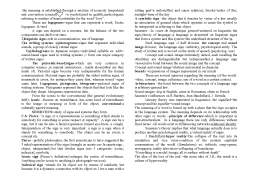Extras din curs
C1 Theories about language
1.Language as a social fact was first suggested by Saussure – Study of language as a system. Important insights in language must be viewed from the point of view of users. Language use reflects the structure of language as a system of units => language should be studied synchronically. Just as the value of each piece in cheese is given by its position, a particular language is a system of units at a given time => language signs. The ancients thought there was a relation between the sign and its referent, but Saussure thinks otherwise (the sign is an abstract unit). Language is a social fact, similar to institutes of language. It is not directly observable and consciously represented by its users.
Emile Durkheim thinks that social facts are characterized as representations in the collective mind, rather than as material entities. When we create an utterance we are faced at each point in its structure with a restrictive set of grammatical options or paradigmatic choices. Systemic grammar refers to a network of relations and language is analyzed at three levels of structure: 1. the clause = the largest unit of grammatical structure. 2. The group = similar to phrase. 3. The word. These respond to the needs to express ideas and social relations.
Language has a dual function: ideational meaning and interpersonal one, both encoded in grammar. Halliday: language and social context are closely tied together (this is true from historical perspective and from the developmental perspective, in children for instance, and from situational perspective whenever people use their language). Unlike universal grammar the premises of systemic grammar require how people interact among them.
2.Language is behavior, this view emerged in American descriptive linguistics under the influence of positivism in philosophy and behaviorism in psychology. Methodological stems of positivism: scientific research must be based on either statements that are totalogical true or they must be based on direct observation. All analyses should be based strictly on the description of observable linguistic behavior. More attention was given to particular languages because we can have more direct data from them => human languages are indefinitely diverse and their interest shifted on devising a mechanism that would take a corpus of words as an input or output. All human behavior could be explained in terms of stimuli and response without reference to mental structures. This theory has two major implications: a. language was characterized as “the totality of utterances that can be made in a speech community”. b. because meaning is not directly observed and studied without introspective judgment => meaning is not a proper object of study
3.The generative approach to language (Chomsky). Language is a mental organ; it is seen as a property of human beings, of human mind: genetic make-up factor, environmental factor for example the numerical ability is unique to humans. Design features of language: recursion, arbitrariness, duality of patterning. These cannot be explained as a result of environmental factors, so we should assume that our linguistic abilities are genetically specified => language is a mental organ. The interaction with the environment triggers the development of language. A finite system of interactive rules and principles which generate an infinite number of expressions, each having a structure of configuration associated with a phonetic form and meaning. At the core of human ability to acquire lg. lies some universal innate properties of grammar. Universal grammar is the essence of human language. Lg. as an object of study is an element of mind which Chomsky calls internalized language.
C. Hackett gives six design features for comparing communication skills among species. They are: 1. the auditory – vocal channel: language is an oral – aural set of processes rather than a visual tactile procedure.
Preview document
Conținut arhivă zip
- Theories about Language.doc
























